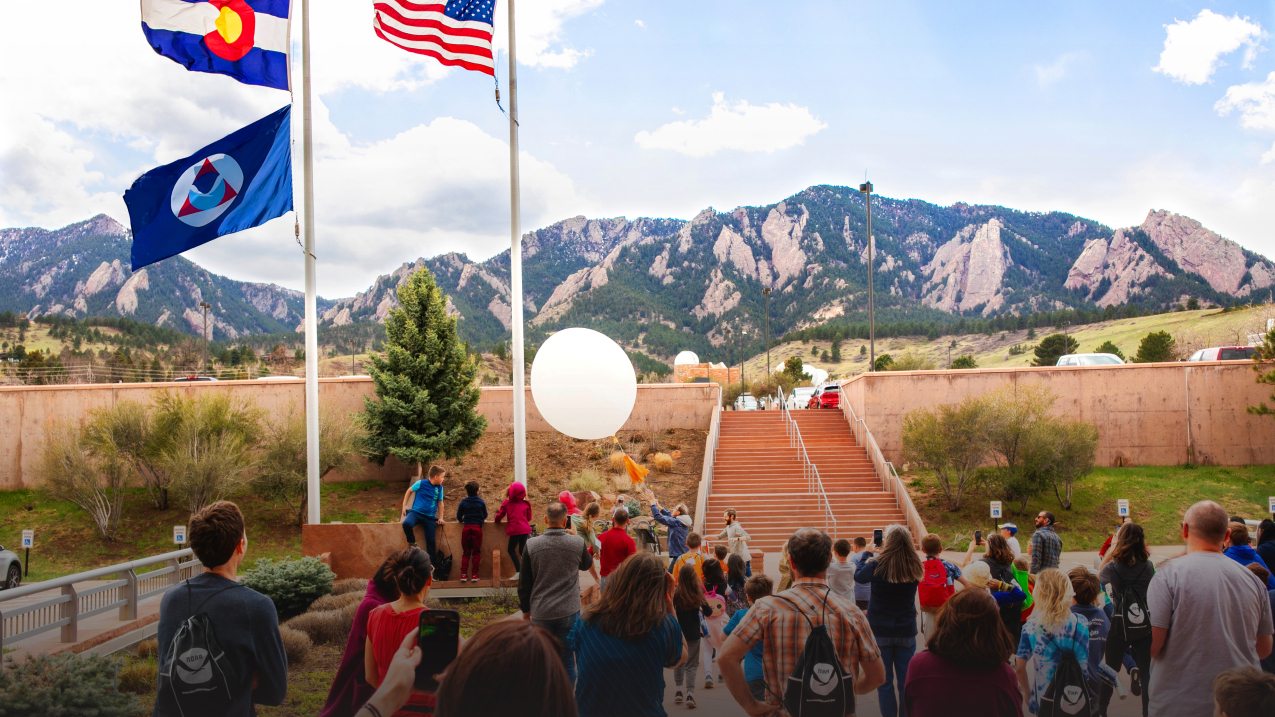
Amidst the gusty winds at the annual 2023 NOAA Boulder Take Your Child To Work Day event, Patrick Cullis and Bryan Johnson led an exhilarating weather balloon launch, fostering hands-on learning and igniting the imaginations of nearly 100 future innovators. (Image credit: Sarah Venema/NOAA Boulder Outreach)
2023 NOAA Education Annual Report
Introduction
Goal 1: Science-Informed Society
Goal 2: Conservation and Stewardship
Goal 3: Ready, Responsive, Resilient
Goal 4: Future Workforce
Goal 5: Organizational Excellence
NOAA Education reaches preschoolers through retirees both inside and outside the classroom, covering topics that span from the surface of the sun to the depths of the ocean. Each chapter in this report showcases our activities in fiscal year 2023 through short highlights, photos, and new resources connected to the goals in the NOAA Education Strategic Plan.
From the director
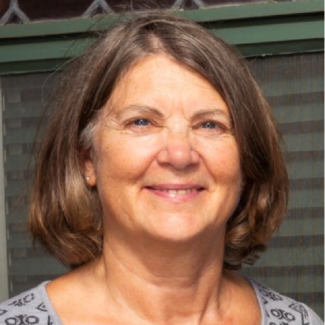
Dear partners and friends of NOAA Education,
On behalf of the NOAA Education community, I’m pleased to present our 2023 Annual Report. This report shows the significant role that education plays in meeting NOAA’s mission of science, service, and stewardship.
Here, we share dozens of highlights that demonstrate the breadth of NOAA’s work in education. These efforts show how NOAA is striving to meet the needs of learners in a changing world. In a year with record-breaking heat and many extreme weather events, our programs rose to the challenge of helping students, educators, and communities become more resilient through education. I am proud of the strong connections we have built with the people and organizations we partner with as we work to make our programs more equitable and accessible.
Each year, I’m honored to watch the young people NOAA trains as scholars, interns, and fellows accomplish great things in support of our agency. In this report, you’ll find examples of just a few of the many students whose projects have contributed to NOAA’s mission. We also share examples of the opportunities we have created to let youth lead the way at NOAA and in their own schools and communities. I hope many of these talented individuals join the NOAA workforce in the years to come.
We are grateful for the dedicated support of our partners and the valuable contributions from the people we serve. Thanks to these collaborative organizations, talented students, and passionate educators, we are able to accomplish so much in support of NOAA’s mission.
Sincerely,
Louisa Koch
Director of NOAA Education
NOAA Education by the numbers
NOAA Education helps people to explore the world around them, broaden their horizons, and learn more about environmental issues. Here are some highlights and pictures showcasing our activities supporting a science-informed society in 2023.
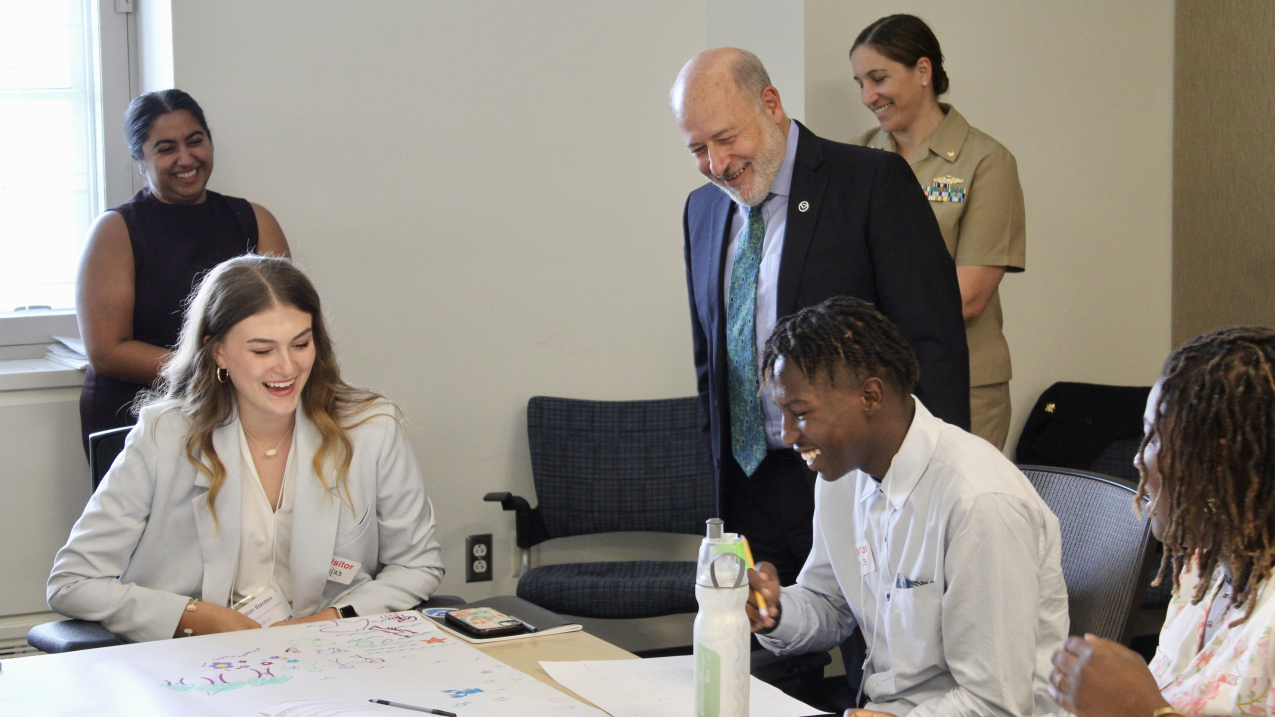
NOAA Administrator Dr. Rick Spinrad met with high school students during the first-ever eeBLUE Young Changemakers Summit. This summit brought nine high school students from across the country to Washington, D.C., from July 19-21, 2023. While in D.C., they participated in hands-on workshops to build their skills in taking ocean and environmental action as well as in advocating for their own voices to be heard by NOAA leadership. After this kickoff summit event, students returned to their home communities to carry out action projects and virtually engage with NOAA leadership throughout the remainder of the school year. (Image credit: NOAA)
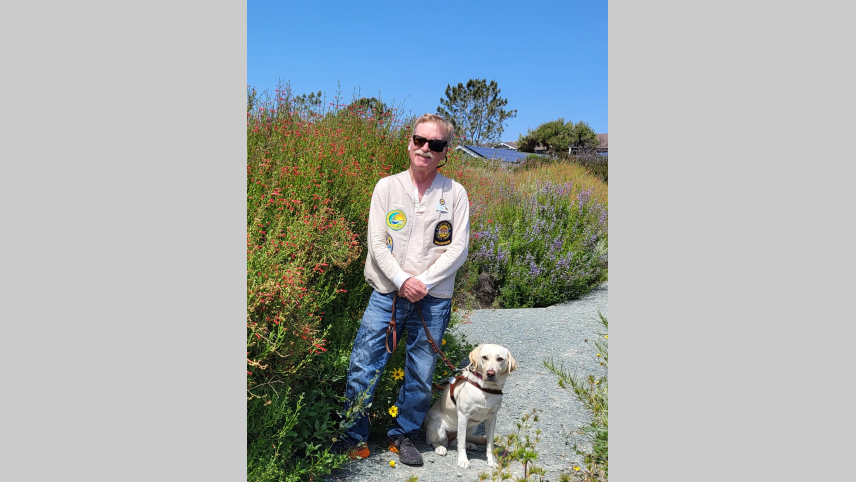
The Tijuana River National Estuarine Research Reserve (TRNERR) is one of 30 reserves in the United States. Ron Peterson, a docent for TRNERR who is blind, and his guide dog Gidget stand near a Baja snapdragon bush in the Reserve's native plant garden where he gives his "Eye-opening Experience Without Sight" Nature Walk every first Saturday. (Image credit: California State Parks)
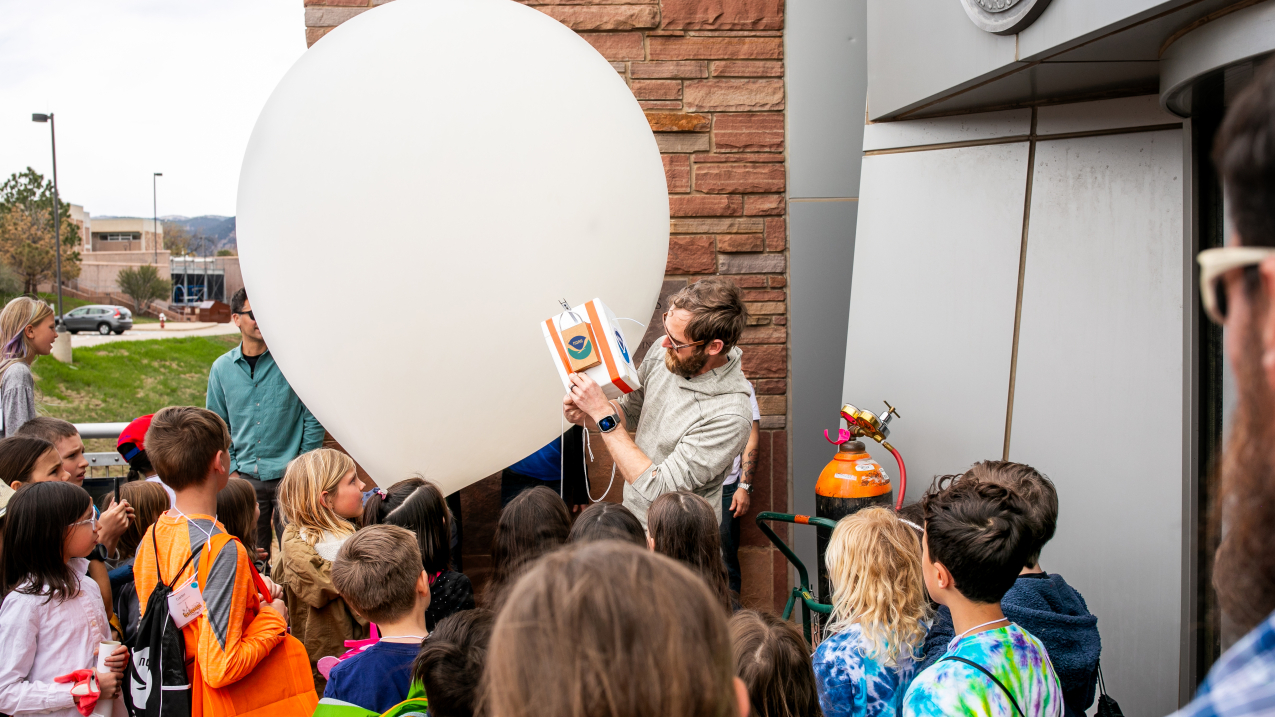
Patrick Cullis, a scientist at NOAA Boulder, prepares a weather balloon for launch at the 2023 Take Your Child To Work Day event, captivating young minds with the magic of science. “Their eager anticipation is a testament to the excitement of witnessing science in action!” said Sarah Venema, Outreach Specialist at NOAA Boulder. (Image credit: Sarah Venema/NOAA Boulder Outreach)
Creating inclusive learning environments
-
Cascade Fisheries offsite link, a Pacific Northwest NOAA Bay-Watershed Education and Training (B-WET) grantee, worked with the Wenatchee School District in Washington to implement a district-wide Schools for Salmon Science Curriculum. All 502 third graders, including English language learners, engaged in water and habitat quality investigations and data collection, salmon life cycle simulations, understanding human impacts and local Tribal salmon recovery efforts, and stewardship.
-
NOAA Science Camp offsite link in Seattle, Washington, worked with Seattle Math, Engineering, Science, Achievement (MESA) offsite link to engage with two middle schools, Showalter and Rainier Prep, for the 2023 camp. By partnering with Foundry10 and the University of Washington’s Cooperative Institute for Climate, Ocean, and Ecosystem Studies offsite link, NOAA waived all registration fees for 32 campers whose schools are located in underserved communities.
-
Massachusetts Institute of Technology (MIT) Sea Grant offsite link's Floating Wetland kit and curriculum were adopted by an Adult Basic Education Cambridge Community Learning Center science class to connect adult learners and first-generation immigrants to the local environment and watersheds. The Floating Wetland educational materials offsite link will be expanded and improved as part of an MIT STREAM Grant offsite link project.
NOAA in the classroom and beyond
- Staff from the Joint Polar Satellite System (JPSS) attended the Las Cruces Space Festival, which was hosted at the Las Cruces Farmers Market in New Mexico. The event drew more than 1,200 people. Staff led activities and passed out outreach materials, including recipe cards that explain how JPSS helps with agriculture. Featured recipes had ingredients people could buy at the market. “It was a great opportunity to have conversations with people about the far-reaching benefits of weather satellites,” said Julie Hoover with JPSS.
- The National Weather Service Virtual School Outreach Team continued to connect NOAA’s weather experts to students and teachers across the country to help teach a wide variety of weather science and safety topics, including tsunamis, hydrology, and space weather! The team gave 261 presentations last year in English and Spanish to 9,455 students from 46 states and four countries. The team also made connections so that an additional 323 requests could be handled by local offices.
- NOAA Research’s Global Ocean Monitoring and Observing Program and international partners hosted roughly 1,000 high school students and 4,000 members of the public during an outreach event for World Ocean Day in Cape Town, South Africa. At the event, Barbara Creecy, South African Minister of Forestry, Fisheries, and the Environment, emphasized the importance of ocean observing and ocean health. Visitors toured the 440 foot South African Agulhas II research vessel and participated in demonstrations of ocean observing Argo floats, drifting buoys, and gliders.
Diving into underwater engineering
- One hundred forty-seven middle school and high school teams participated in the annual International SeaPerch ROV Challenge offsite link to test their mettle in designing remotely operated vehicles (ROVs). Hosted by Robonation offsite link, this year’s challenge was supported via the Ocean Exploration Cooperative Institute offsite link and funded by NOAA Ocean Exploration. The ROVs competed on a course designed to mimic the modern methods used to explore the deep ocean, including seafloor mapping, biological sampling, and water sampling.
- The Teacher at Sea (TAS) Alumni Association’s Project ROVe offsite link (Remotely Operated Vehicles for educators) is a professional development opportunity for NOAA Teacher at Sea alumni interested in incorporating ROVs and other marine technology into their classrooms. Project ROVe includes an online course followed by hands-on, in-person workshops and small grant opportunities. Since 2022, 29 TAS alumni have completed the course, and 14 participants have successfully implemented ROV projects in their classrooms. In Arizona, for example, community college biology professor Jeff Miller, Ph.D., brought a team of students offsite link to compete at the MATE ROV World Championship offsite link in Colorado, where they finished fourth overall in their class.
Students as scientists
- Apalachicola National Estuarine Research Reserve turned the entire watershed into a classroom for high school students from Atlanta, Georgia, and Florida’s Gulf Coast. Students traveled from the headwaters of the Apalachicola River system to the reserve, learning how to test water quality and stopping to talk to farmers, water treatment experts, and recreational users. Classes exchanged journals, sharing their perspectives on how water impacts humans and wildlife.
- NOAA Planet Stewards provided educators with funding and the know-how to implement hands-on, action-based stewardship projects. Many projects provide opportunities for student-led research. For example, students in rural Pennsylvania analyzed the carbon sequestration ability of a 1,400-acre forested area using technology such as LiDAR offsite link (Light Detection And Ranging), high-resolution photography, and ground truthing. Students in Baltimore, Maryland, conducted citizen science monitoring of air quality, surface temperature, and weather conditions in a range of urban environments to understand the importance of urban green spaces in mitigating the impacts of climate change.
- Olympic Coast National Marine Sanctuary Washington Service Corps member Brendon Rager participated in a multi-day visit to the Quileute Tribal School marine science class. Students in the school’s marine science class researched ocean acidification and climate issues facing their community. Students then presented on ocean and climate-related issues that may impact the resources the tribe relies on, such as Dungeness crab and salmon.
NOAA Education provides resources to help people make informed choices and take actions to protect the things they care about. Here are some highlights and pictures showcasing our activities supporting stewardship and conservation in 2023.
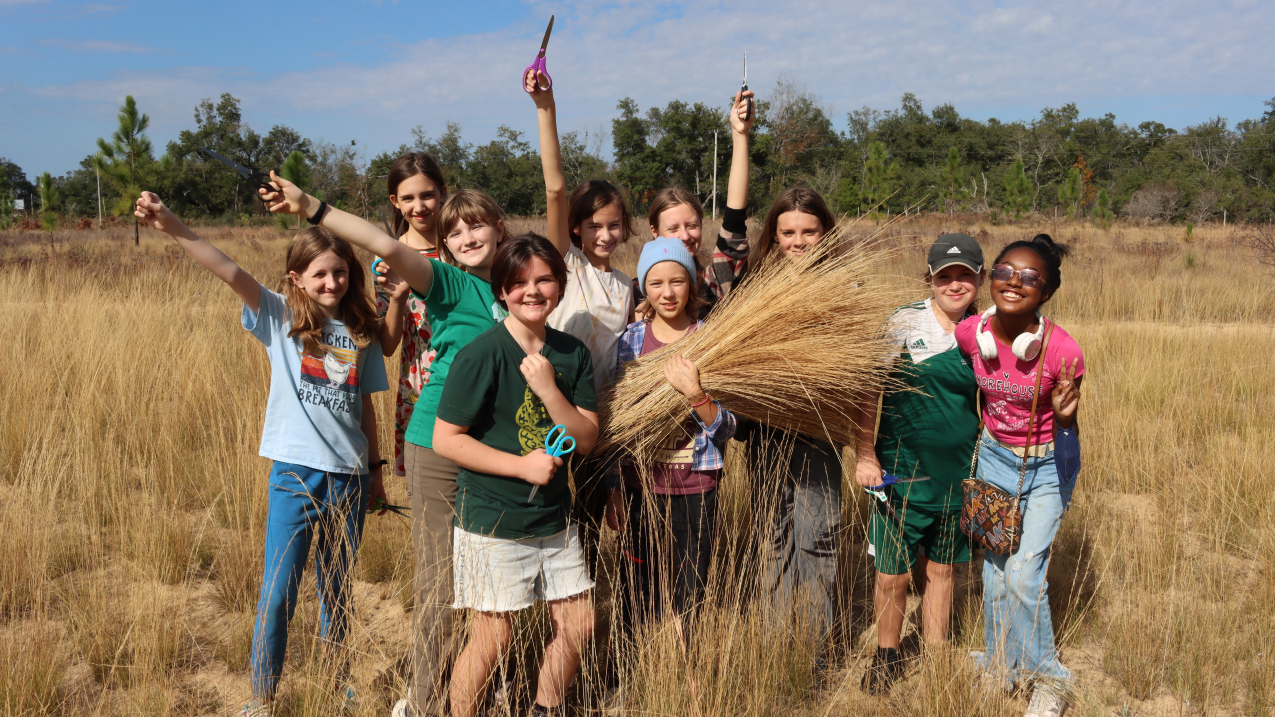
Middle school students participated in the NOAA Planet Stewards project, "Propagating Understory Restoration Plants for Longleaf Ecosystems." Here, they celebrated a successful day harvesting wiregrass seed spikes from a seed donor site at the Apalachicola Bluffs and Ravines Preserve. They will use the seeds to grow and replant native wiregrass in an effort to restore a nearby longleaf pine ecosystem. (Image credit: Rob Diaz De Villegas)
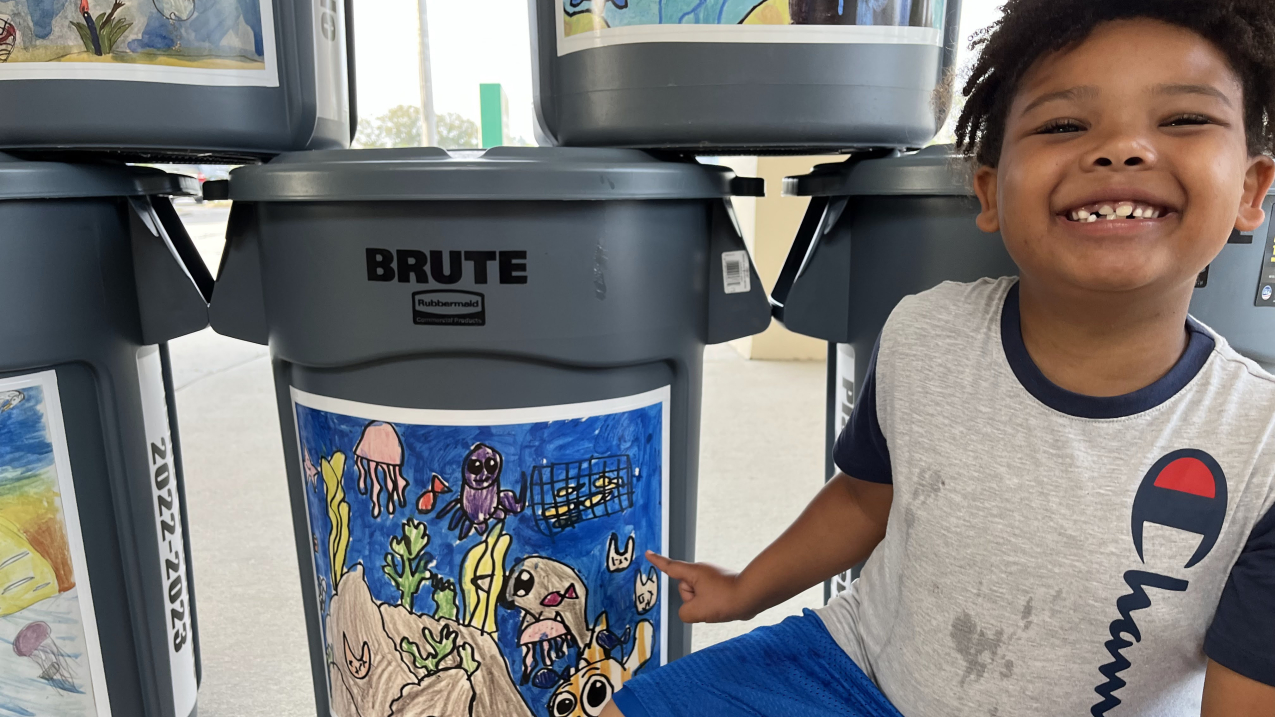
Xavier, a first grade student in Panama Beach, Florida, kneels with a beaming smile next to his winning entry in the school's Marine Debris Art Contest. Xavier's artwork has been turned into a giant sticker and placed onto the side of a large garbage can, which will be placed with many others around the town of Panama Beach, Florida. The art contest was part of the NOAA Planet Stewards funded project, "Clean Up and Restore: Empowering Our Future Changemakers." (Image credit: Kelley Hodges)
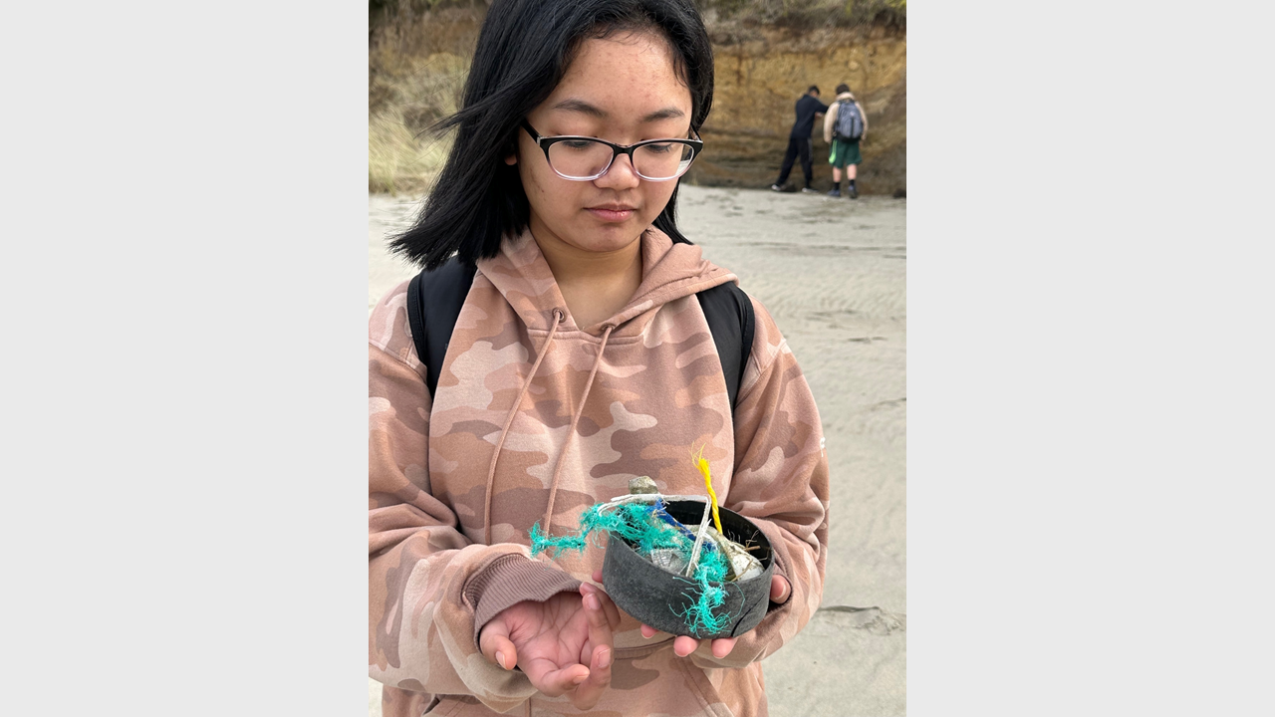
A seventh grade student at the Oregon Dunes National Recreation Area looks down with concern at the small pile of marine debris in her hand that she has just collected from the beach. (Image credit: Amy Tregoning)
Making NOAA's special places more equitable and accessible
- The Guana Tolomato Matanzas (GTM) Research Reserve offsite link expanded its GTM for All initiative, which seeks to provide access to the estuary for students who may otherwise miss out on these experiences. Building on community partnerships, events included an overnight summer camp for urban core students, an Estuary Day at the reserve, and monthly programs for verbal and non-verbal individuals on the autism spectrum.
- Old Woman Creek National Estuarine Research Reserve partnered with the Erie County Board of Developmental Disabilities offsite link by working together to offer new programming. Participants learned about hiking in different seasons, joined public paddling trips, or became stewardship volunteers to help with land management and invasive species removal. This partnership was the impetus for a new public program called Tranquil Tuesdays that offers low-impact and accessible experiences at the reserve like birding, meditation at the beach, and gentle impact hiking.
- Florida Keys National Marine Sanctuary visitor center has been certified offsite link as a Sensory Inclusive facility. Exhibits were designed using highly interactive features so visitors can see, hear, and touch sanctuary habitats. Visitors of all backgrounds have equitable access to the exhibits, including a wheelchair-friendly part of an exhibit where visitors can feel like they are paddle boarding. Sensory bags are available at the front desk to provide people a way to help lessen sensory overload, if needed. Interpretive audio tours are available in English, Spanish, French, and Haitian Creole.
Beyond the sciences: Communicating through art, storytelling, and more
- Through the NOAA Sea Grant-Marine Debris Program Partnership, Wisconsin Sea Grant offsite link and American Players Theatre offsite link authored a play about marine debris offsite link with a world premiere event and a stewardship field day. Wisconsin Sea Grant offsite link used the power of storytelling and performance to inspire new stewards of Lake Michigan. To facilitate future performances, they shared a full script offsite link, marketing resources, and audience participation materials in English, Spanish, and Hmong.
- With the help of a NOAA Ocean Acidification Program Education Mini-Grant, a Title I school in the Gulf of Mexico partnered with inland schools in Arizona, Kansas, South Dakota, and Texas to spread awareness and understanding of ocean, coastal, and freshwater acidification. The program included development of classroom and field activities for students and used sixth graders as student messengers between and within schools along the coast and inland states. The program exceeded expectations and reached 488 students and 21 classrooms, including 14 inland classrooms.
- Through a funding opportunity from NOAA Planet Stewards, students in Panama Beach and Broward County, Florida, restored nearly 18,000 square feet of three different coastal ecosystems. They removed more than 57 pounds of marine debris and more than 2,300 square feet of invasive species. They also grew and transplanted sea grasses, dune grasses, and mangroves. Students worked to educate their fellow students and community members about the issue of marine debris through art projects and installations.
- The Natural Resource Recruitment program, provided by California Bay Watershed Education and Training (B-WET) grantee Ventana Wildlife Society offsite link, partnered with Alternative Education in Monterey County, California. The program offered a workshop series for incarcerated teens focusing on careers in natural resources. School partners provided weekly recurring outdoor experiences throughout the school year for teens and offered other programs serving this population that focus on music and the arts, technology, and therapy.
Learning with sustainable living marine resources
- NOAA’s National Centers for Environmental Information (NCEI) participated in "My Two Boots-A Wetland Experience,” a full-day, environmental science-themed event for the Gautier-Pascagoula School District. Nearly 150 students visited NCEI’s booth and participated in a miniature trawling activity, where they learned how fisheries data is collected, processed at sea, then analyzed, reported, and made into products by data centers such as NCEI.
- Hawaiʻi Sea Grant offsite link helped Waiʻanae High School secure $2.5 million from the Hawaiʻi Legislature to support hatchery development, providing students with hands-on experiences in managing aquaculture systems. Hawaiʻi Sea Grant continues to provide guidance on the design of the hatchery. Other partners are helping to provide fish fry for the new hatchery, as well as supporting two new staff who are receiving training in hatchery methods.
- Fishadelphia, a community seafood program in Philadelphia, Pennsylvania, received funding from NOAA Fisheries and New Jersey Sea Grant offsite link to train students while providing local seafood to restaurants and residents through a biweekly seafood share program. In fiscal years 2022 and 2023, this provided 40 weeks of after-school activities and employment for 37 youth from seven schools in addition to many pounds of fish and shellfish to local customers and restaurants.
Youth lead the way
- With support from the NOAA Marine Debris Program, Ocean Conservancy offsite link inspired business champions and youth ocean ambassadors to prevent single-use plastic waste in Miami-Dade County, Florida. Participating Florida youth became Junior Sustainability Consultants, gaining the knowledge and skills needed to work with local businesses to reduce single-use plastics.
- In 2023, the NOAA Ocean Guardian Youth Ambassador Program empowered 250 students to act as youth leaders in their school or their community. The program provides a new level of engagement for youth aged 13-18 by developing a network of youth who made commitments to ocean conservation and the stewardship of our blue planet. Youth ambassadors submitted approximately 100 conservation and stewardship project ideas to lead at their school or in their community.
- NOAA expanded efforts to uplift youth voices through a pilot program connecting youth perspectives to NOAA leaders. In 2023, the eeBLUE Young Changemakers Fellowship selected nine participants for a year-long program designed to empower high school students to take action on ocean and environmental issues and bring their perspectives into NOAA’s decision making process.
NOAA Education helps people build the foundation of understanding that will enable them to be ready, responsive, and resilient to future environmental hazards. Here are some highlights and pictures showcasing our activities supporting readiness, responsiveness, and resilience in 2023.
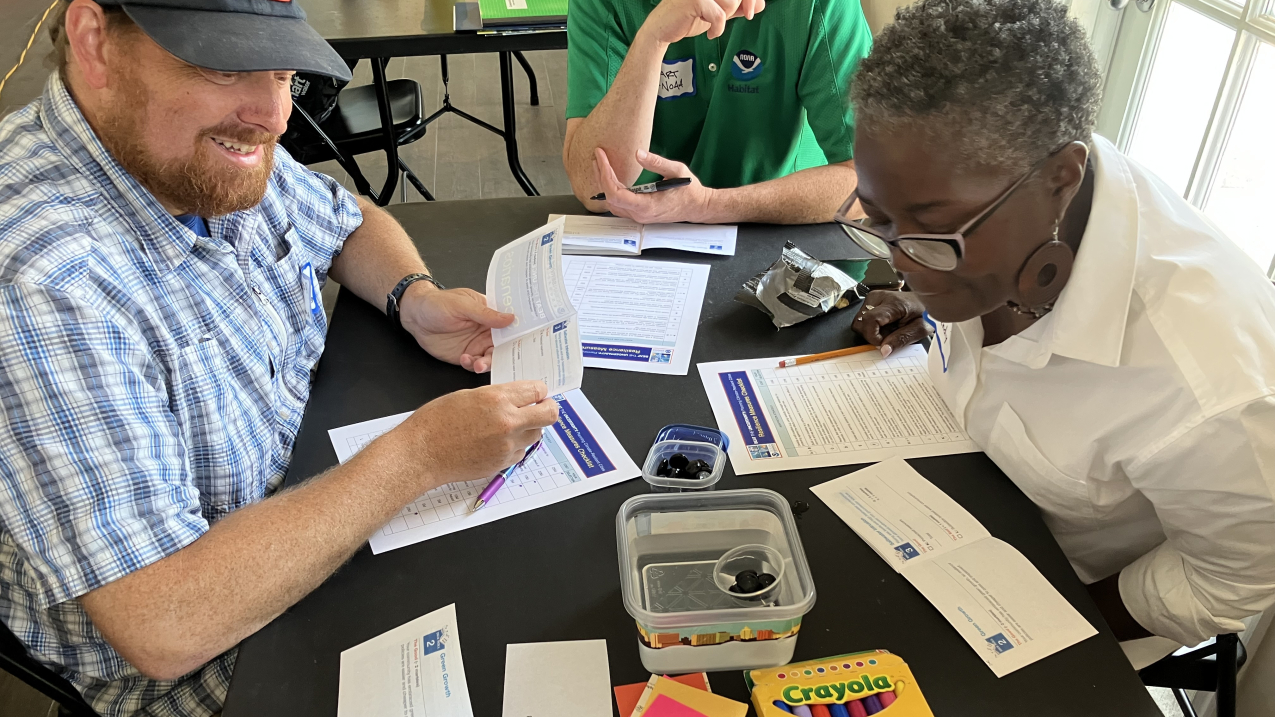
At a three day workshop for educators in the Washington, D.C., and Baltimore, Maryland, area, educators played "Beat the Uncertainty," a role playing game from NOAA Ocean Service Education. The game helps educators learn how coastal communities can become more resilient. The workshop was organized by NOAA Planet Stewards, the NOAA Chesapeake Bay Office, and the Maryland Association for Environmental and Outdoor Education. (Image credit: Bruce Moravchik/NOAA)
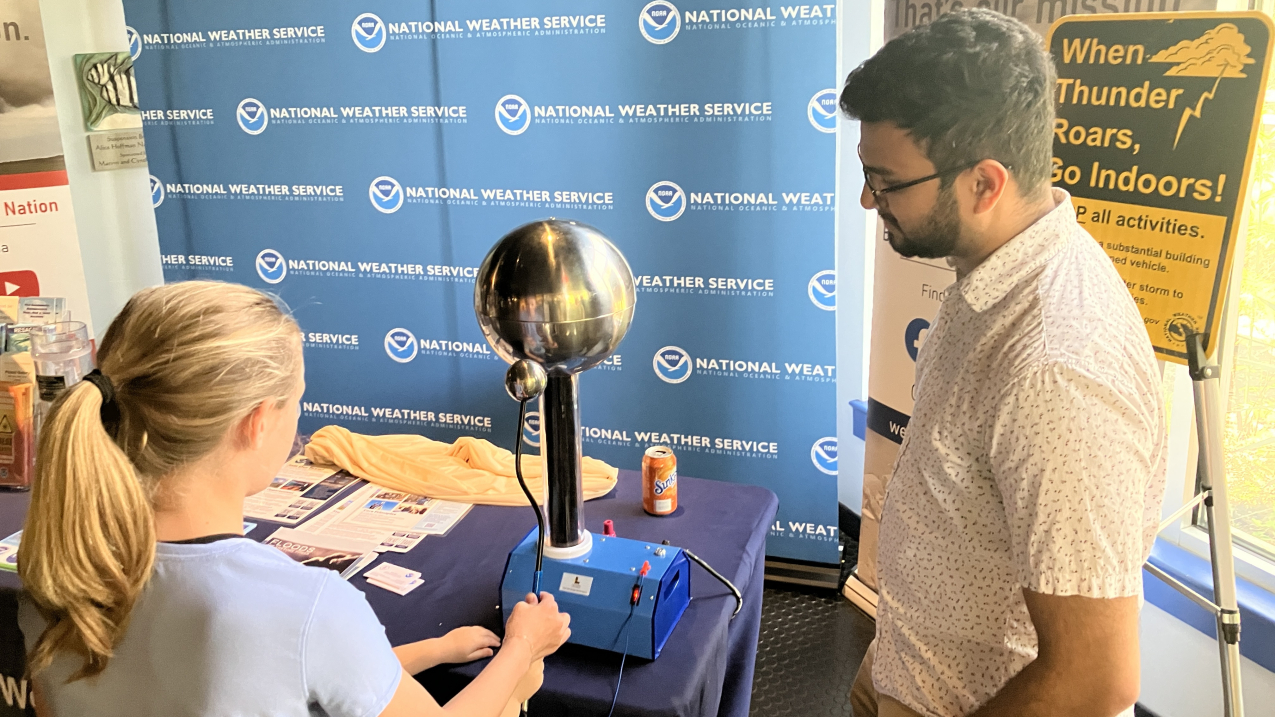
At the North Carolina Aquarium at Pine Knoll Shores, forecaster Rohan Jain and other staff from the National Weather Service brought a Van de Graaff machine to teach about lightning safety. The Van de Graaff machine that two children are using here generates electric sparks in a similar way to how lightning forms in the atmosphere. The aquarium received a grant from NOAA in conjunction with the Coastal Ecosystem Learning Center (CELC) Network to help implement the event so coastal communities can learn how to mitigate climate change impacts (Image credit: Warning Coordination Meteorologist Erik Heden/National Weather Service Morehead City Forecast Office)
Equipping educators to teach about climate change
- NOAA Planet Stewards partnered with two National Estuarine Research Reserves, NOAA Fisheries, the Maryland Association for Environmental and Outdoor Education, and the Detroit Zoological Society to offer professional development workshops for educators who are working with underserved and underrepresented student populations. These three-day workshops in California, Oregon, Maryland, and Michigan focused on understanding the science of climate change and its disproportionate impacts on underserved and underrepresented communities.
- Grand Bay National Estuarine Research Reserve was awarded a National Academy of Sciences capacity building grant for their program, "Conceptualizing Human Alterations and Natural Growth in Estuaries and Savannas" (CH∆NGES). Reserve scientists and educators collaborated with local teachers to develop lesson plans and programming for 250 students and 18 educators, and ventured out on two field days. They also adapted materials for students as young as fifth graders in the On the Road Program, working with more than 200 more students.
Reaching communities through education
- In January 2023, NOAA Research helped support two international heat island mapping campaigns in Rio de Janeiro, Brazil, and Freetown, Sierra Leone. For both Brazil and Sierra Leone, January is the hottest time of the year. Both cities plan to use this data to inform projects to create a cooler future for their most vulnerable residents. These cities joined the 70 U.S. communities whose citizens have helped to map their hottest neighborhoods.
- National Weather Service Warning Coordination Meteorologist Nicole Ferrin and General Meteorologist Caleb Cravens from the Juneau Weather Forecast Office traveled to Kake, Alaska, to meet with partners, give a weather spotter training class, and visit five classrooms. Kake is a Tlingit Native village, with approximately 400-500 year-round residents. This was the first outreach trip by anyone from the National Weather Service to Kake since 1992.
- NOAA’s Environmental Literacy Program provided $2.9 million to six projects to empower people to protect themselves and their communities from local climate impacts. The newest cohort of grant recipients, many of which are first-time federal grant recipients, represents organizations that are directly engaging the most underserved and vulnerable communities. The grantees are using educational approaches to create resilience and address environmental justice concerns, such as working with faith-based organizations to create climate resilience leaders and creating opportunities for public school students to learn about solar installation work.
Students design solutions for resilient communities
- Project Oceanology offsite link, a New England NOAA Bay Watershed Education and Training (B-WET) grantee, worked with 130 seventh graders from Teachers Memorial Global Studies Magnet Middle School in Norwich, Connecticut, to investigate ways they could make their new school building more resilient. Students proposed climate resilient solutions, including cost-benefit and modeling analyses for the use of solar panels, electric buses, rain gardens, and composting. Next, students participated in a symposium where they presented to school administrators, local government officials, and other community members.
- A team of 11 students from Delaware Sea Grant offsite link's Coastal Resilience Design Studio offsite link created a “town center” plan for residents and visitors to the town of Bowers Beach. The team explored landscape design interventions to add amenities and better connect the town's main corridor, beach, and harbor area, while improving stormwater management. The Federal Highway Administration's National Scenic Byways Program awarded $475,000 to implement portions of the plan.
NOAA Education introduces young people to NOAA careers and prepares emerging professionals for the workforce, focusing on equity and inclusion at every step along the way. Here are some highlights and pictures showcasing our activities supporting the future workforce in 2023.
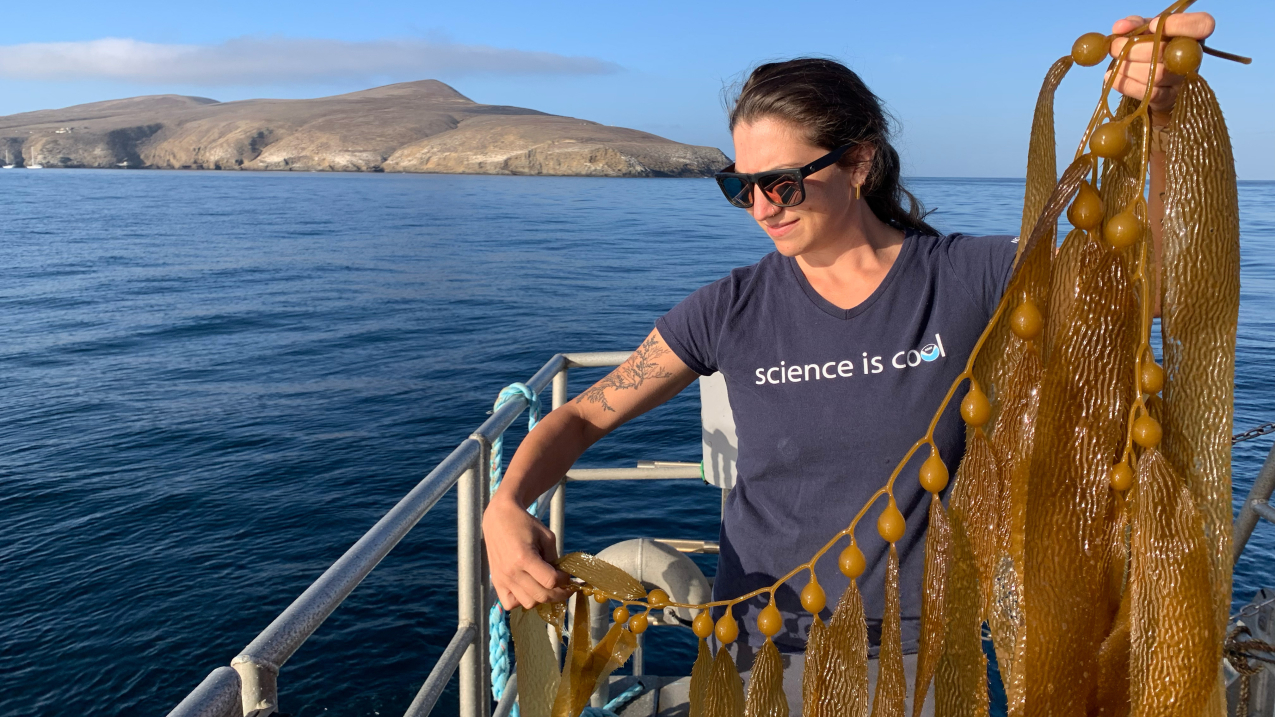
Natalie Dornan, an Office of National Marine Sanctuaries Foster Scholar, studies kelp forest health and conducted much of her research in NOAA's Channel Islands National Marine Sanctuary. Here, Natalie stands on the back of the NOAA research vessel Shearwater holding a large piece of kelp. (Image credit: Claire Fackler/NOAA National Marine Sanctuaries)
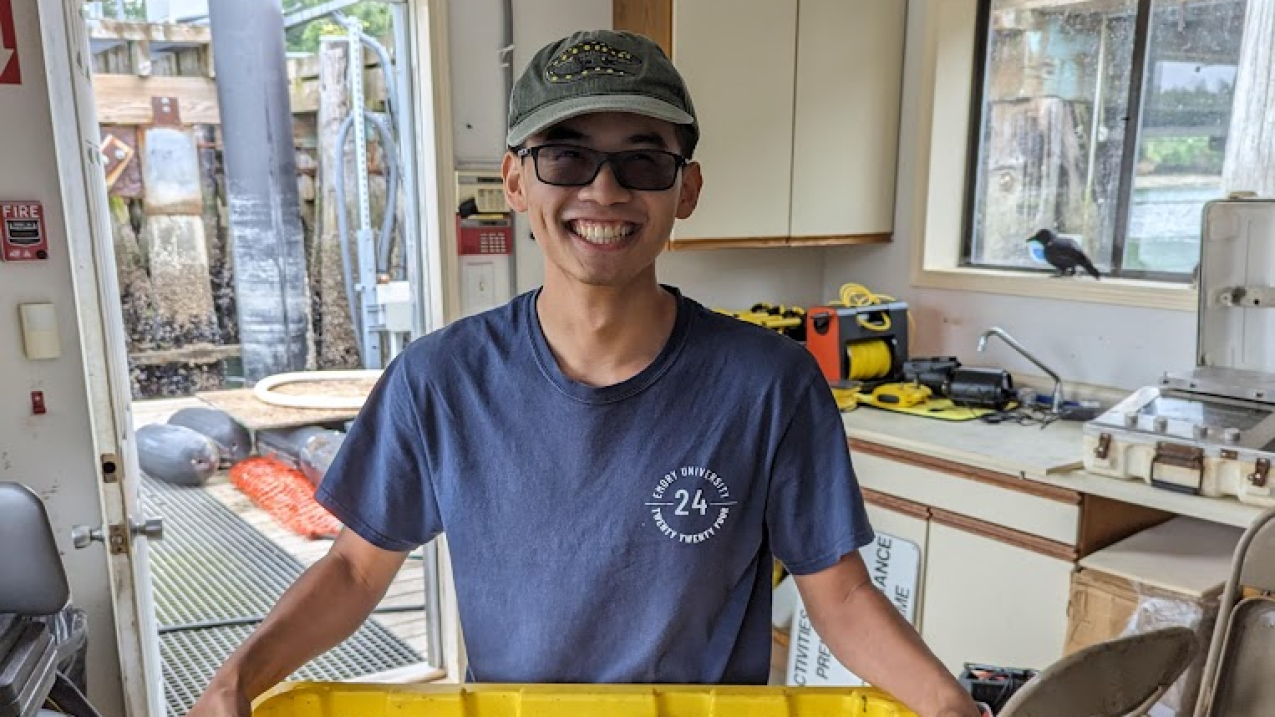
Nick Chang, a 2022 NOAA Hollings scholar, holds a tray of oysters prepped for growth measurements at the Northwest Fisheries Science Center Manchester field station. (Image credit: Craig Norrie/University of Washington School of Aquatic and Fishery Sciences)
Getting to know NOAA — in person!
- The NOAA Office of Education selected 130 Ernest F. Hollings undergraduate scholars and 12 José E. Serrano Educational Partnership Program with Minority Serving Institutions undergraduate scholars in 2023. For both programs, orientation, internships, and closing ceremonies were the first to occur in person since the pandemic in 2020.
- Career days are back for the nation’s national marine sanctuaries and two marine national monuments. Staff participated in numerous career days targeting about 1,700 students. Staff from across the sanctuary system provided hands-on activities and engaging presentations to introduce students to NOAA careers and a wide range of STEM sciences, including oceanography, marine biology, marine technology, chemistry, ecosystem dynamics, and much more.
- A team of 34 NOAA staff participated in the Society for Advancing Chicanos/Hispanics and Native Americans in Science offsite link (SACNAS) National Diversity in STEM Conference in San Juan, Puerto Rico, in October 2022. This cross-agency effort provided many opportunities for students to learn more about careers at NOAA, including an exhibit booth, professional development sessions, and mentorship opportunities.
Interns building community connections
- Claire Burnet, one of five summer interns hosted by the NOAA Chesapeake Bay Office, identified 267 high-quality climate change curriculums from across the country during her 12-week internship. She found that although there are many resources available, more could be done to connect educators to existing resources and to tailor resources to support local schools and community needs. This work provides useful recommendations to the climate education community, while also supporting NOAA’s Chesapeake Bay Office’s environmental literacy team.
- The Weather Forecast Office in Morehead City, North Carolina, worked with Isabella Kemp, a NOAA Hollings undergraduate scholar, to create a community vulnerability atlas and develop a more equitable office outreach plan. Isabella used her background in social science to help combine data from algorithmic databases, social vulnerability indices, and input from emergency managers and communities to create the atlas. Acting on the results of the atlas, National Weather Service staff reached 4,000 students, visiting at least one school in every county in their forecast area, including many for the first time.
Students get an early start with K-12 career programs
- EcoRise Youth Innovations, a NOAA Environmental Literacy Program grantee, provided Texas high school students with internships through the Building a Green Texas Project. The interns directly engaged with scientists, civic leaders, green building professionals, and NOAA data and staff. They wrestled with the real-world impacts of climate change, scientific uncertainty, cultural knowledge, and equity regarding community resilience.
- In partnership with Lake Superior State University, Michigan Sea Grant offsite link helped create an aquaculture career pathway that carries students through K-8 learning, hands-on experiences, and an aquaculture challenge offsite link into college programs and toward aquaculture jobs. As of 2022, the program has reached 200 educators, 1,000 youth, and 500 aquaculture challenge participants. Twenty-five Lake Superior State University students are enrolled in or have completed aquaculture degree programs; recent graduates hold high-paying aquaculture jobs.
Building the best future workforce
- The NOAA Educational Partnership Program with Minority Serving Institutions Cooperative Science Centers (CSCs) ensure that students are competitive and well prepared for the future NOAA mission-enterprise workforce. Through graduate internships with NOAA mentors, CSC students gained mastery in NOAA mission competencies and skills. Centers also offered Center-wide Core Competency Courses and Annual Cohort Experiences to provide training and development opportunities for CSC students while engaging and collaborating with NOAA scientists. In fiscal year 2023, the CSCs supported 213 students. For the first time, the program also provided support for four CSC undergraduate students to complete 10-week summer internships at NOAA.
- Recognizing that the Dr. Nancy Foster Scholarship Program wasn’t achieving its diversity goals, the Office of National Marine Sanctuaries made changes to remove barriers to enhance diversity within the applicant and recipient pool. Now the program is seeing signs that these efforts are working: in 2023, 48% of applicants and 71% of selected scholars identified as minorities.
- NOAA Ocean Exploration and the National Marine Sanctuary Foundation awarded 12 Ocean Odyssey grants to support diversity, equity, inclusion, and accessibility in ocean literacy and ocean exploration workforce development. The grants support projects and partners that engage communities that have been historically marginalized from ocean science and exploration career paths.
- Sea Grant and the NOAA Climate Program Office, with support from the NOAA Office for Coastal Management, launched a Climate-Ready Workforce grant competition. These grants will assist communities in coastal and Great Lakes states, territories, and tribes to form partnerships with employers to train workers and place them into jobs that enhance climate resilience. NOAA envisions making between 10-20 awards under this competition, at amounts ranging from $500,000-$10 million each.
From award-winning educators to cross-agency collaborations, the NOAA Education community strives to build an inclusive environment for the people we serve and to ensure that the public has access to Earth science education. Here are some highlights and pictures showcasing our activities for organizational excellence in 2023.
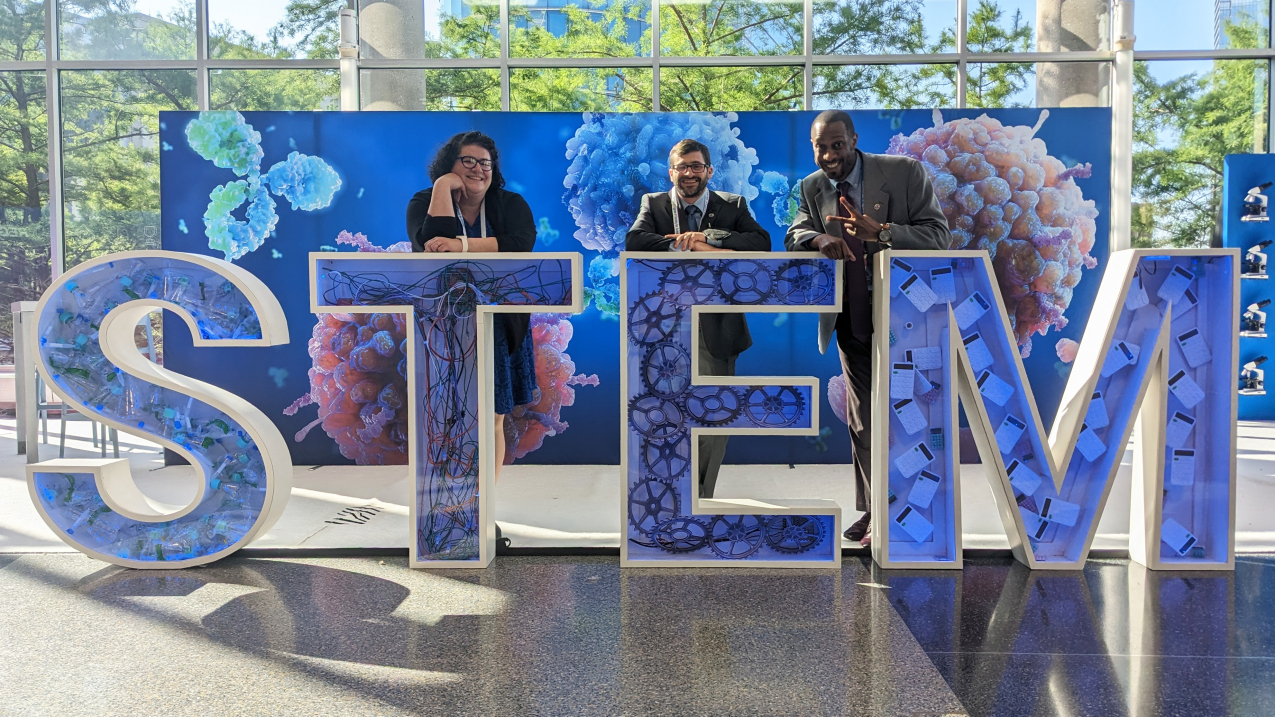
Judges for the NOAA Special Award at the 2023 Regeneron International Science and Engineering Fair (ISEF) pose after a day of judging student research projects. Judging for the Special Awards was held on May 17, 2023. From left to right, Bekkah Lampe, Tom Di Liberto, and Will Lyons. (Image credit: NOAA)
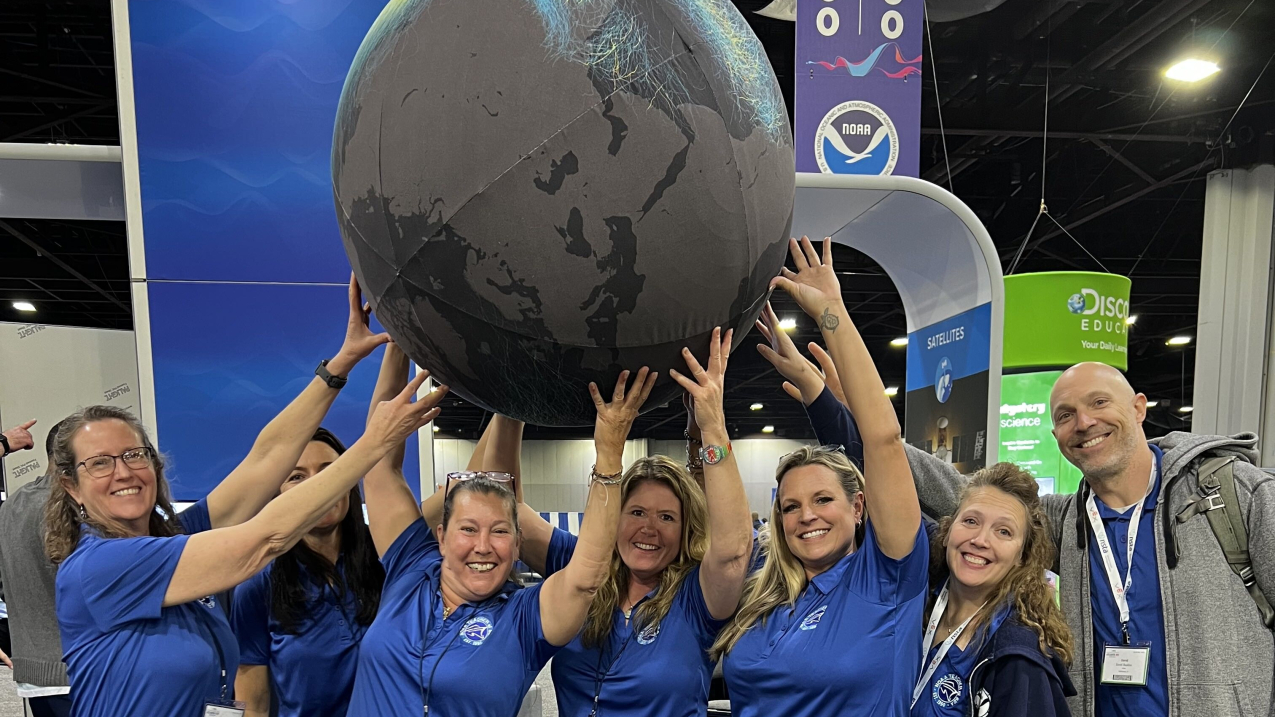
At the 2023 National Science Teaching Association (NSTA) conference in Atlanta, NOAA hosted an exhibit booth, bringing many NOAA staff and affiliates together. Here, alumni from the NOAA Teacher at Sea Program hold up an inflatable globe showing hurricane tracks in front of the exhibit booth. (Image credit: Jenny Goldner/NOAA Teacher at Sea)
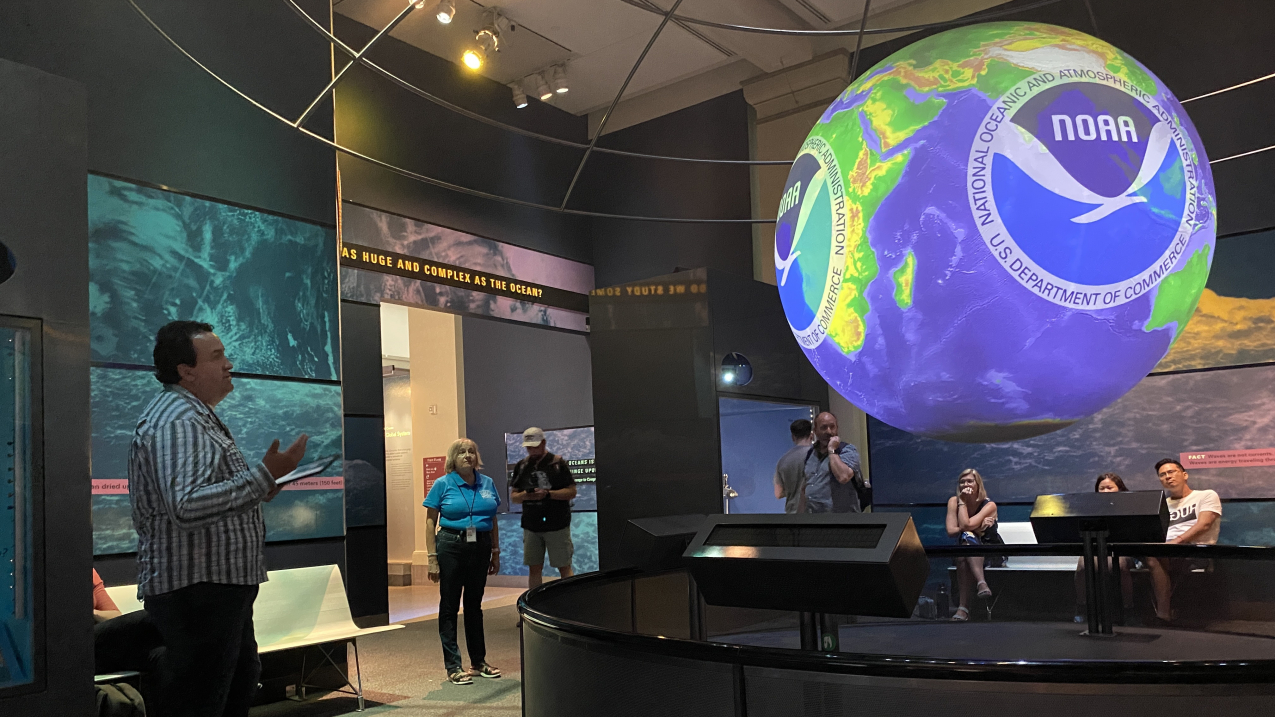
Science On a Sphere in Silver Spring manager, Juan Pablo Hurtado, presented a dataset on the Smithsonian National Museum of Natural History's sphere on World Ocean Day 2023. The NOAA Marine Debris Program released two new videos for NOAA Science On a Sphere, Introduction to Marine Debris and Global Marine Debris Model, which debuted at this event. (Image credit: NOAA Education)
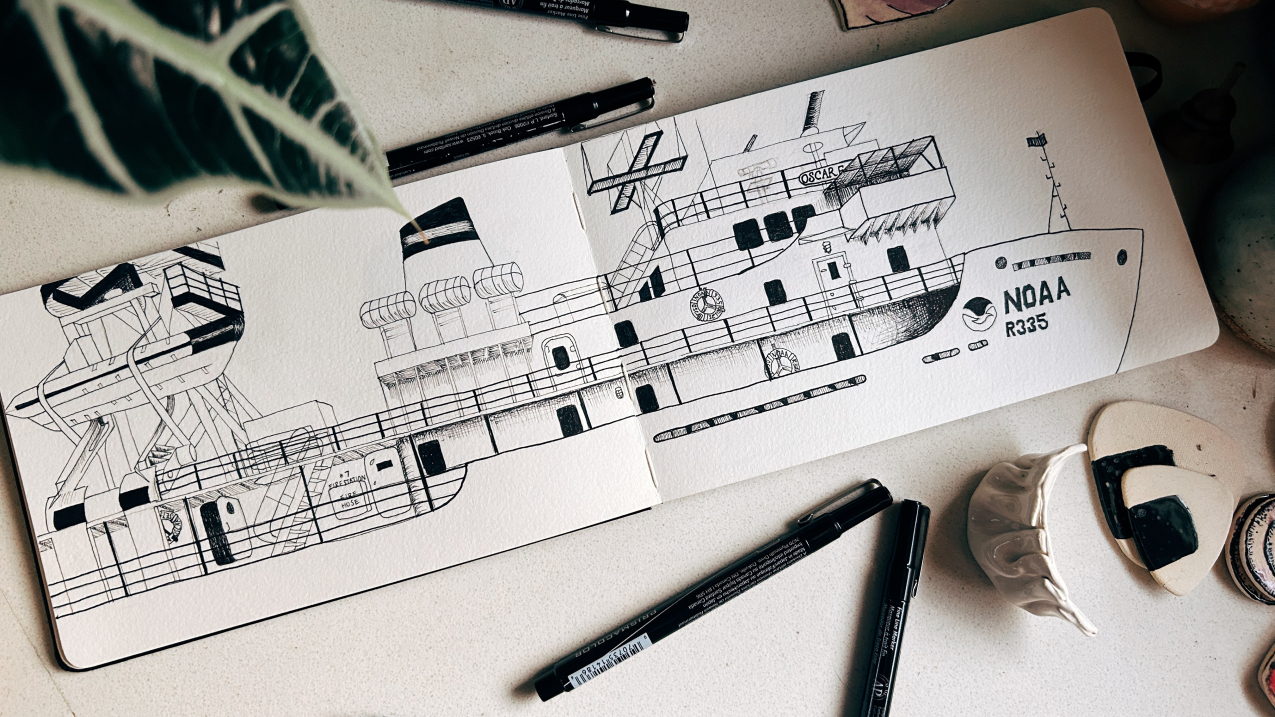
NOAA Teacher at Sea Gail Tang sailed on a Cetacean and Ecosystem Assessment Survey in the Hawaiian Islands. This is her rendition of the ship she sailed on, NOAA Ship Oscar Elton Sette. Gail teaches mathematics at the University of La Verne in La Verne, California. (Image credit: NOAA Teacher at Sea program)
Working together to support NOAA's mission
- NOAA released the new NOAA Citizen Science Action Plan, which details how NOAA will advance public participation in NOAA’s mission. The plan ensures that collaboration, inclusiveness, and data quality remain core considerations of the projects that NOAA offers. Citizen Science is one of NOAA’s six science and technology focus areas.
- NOAA’s Climate Education Program led the development of a new Federal Climate Engagement and Capacity Building Interagency Group as part of the United States Global Change Research Program. This group coordinated federal agency climate and global change efforts focused on education, community engagement, public awareness, workforce development, and training across 30 federal departments and agencies including NOAA, the Smithsonian Institution, the U.S. Agency for International Development, and the Federal Emergency Management Agency.
- NOAA’s Climate Education Program and the Smithsonian Science Education Center co-led the U.S. Global Climate Research Program’s Climate Engagement and Capacity Building Interagency Group effort to update the highly influential 2009 Climate Literacy Guide. Educators, youth, and the public were invited to participate in 21 listening sessions and to submit written comments on what should be in an updated guide. The extensive input from 699 attendees, in addition to 72 written responses from across 52 countries, provided critical information on the 2024 guide. The updated guide will be released in spring of 2024.
Educator-to-educator connections
- Eight educators from Maine, Georgia, Ohio, Woods Hole, Mississippi-Alabama, Lake Champlain, Washington, and Hawaiʻi Sea Grant programs participated in an educator exchange to facilitate professional learning and the cultivation of relationships. Educators observed each other’s programs offsite link and brought new ideas back to their home Sea Grant program.
- The NOAA Office of Education and NOAA Communications led a one-NOAA presence at the 2023 National Science Teaching Association conference in Atlanta, Georgia, which drew an estimated 7,000 attendees. NOAA Teacher at Sea alumna Jenny Goldner shared offsite link how she and other alumni are key interfaces between NOAA and the educators at NSTA. At the conference, alumni help teachers understand how to access and use these valuable resources in the classroom and anticipate questions the attendees might have.
NOAA Education reaches preschoolers through retirees both inside and outside the classroom, covering topics that span from the surface of the sun to the depths of the ocean. Each chapter in this report showcases our activities in fiscal year 2023 through short highlights, photos, and new resources connected to the goals in the NOAA Education Strategic Plan.
From the director

Dear partners and friends of NOAA Education,
On behalf of the NOAA Education community, I’m pleased to present our 2023 Annual Report. This report shows the significant role that education plays in meeting NOAA’s mission of science, service, and stewardship.
Here, we share dozens of highlights that demonstrate the breadth of NOAA’s work in education. These efforts show how NOAA is striving to meet the needs of learners in a changing world. In a year with record-breaking heat and many extreme weather events, our programs rose to the challenge of helping students, educators, and communities become more resilient through education. I am proud of the strong connections we have built with the people and organizations we partner with as we work to make our programs more equitable and accessible.
Each year, I’m honored to watch the young people NOAA trains as scholars, interns, and fellows accomplish great things in support of our agency. In this report, you’ll find examples of just a few of the many students whose projects have contributed to NOAA’s mission. We also share examples of the opportunities we have created to let youth lead the way at NOAA and in their own schools and communities. I hope many of these talented individuals join the NOAA workforce in the years to come.
We are grateful for the dedicated support of our partners and the valuable contributions from the people we serve. Thanks to these collaborative organizations, talented students, and passionate educators, we are able to accomplish so much in support of NOAA’s mission.
Sincerely,
Louisa Koch
Director of NOAA Education
NOAA Education by the numbers
NOAA Education helps people to explore the world around them, broaden their horizons, and learn more about environmental issues. Here are some highlights and pictures showcasing our activities supporting a science-informed society in 2023.

NOAA Administrator Dr. Rick Spinrad met with high school students during the first-ever eeBLUE Young Changemakers Summit. This summit brought nine high school students from across the country to Washington, D.C., from July 19-21, 2023. While in D.C., they participated in hands-on workshops to build their skills in taking ocean and environmental action as well as in advocating for their own voices to be heard by NOAA leadership. After this kickoff summit event, students returned to their home communities to carry out action projects and virtually engage with NOAA leadership throughout the remainder of the school year. (Image credit: NOAA)

The Tijuana River National Estuarine Research Reserve (TRNERR) is one of 30 reserves in the United States. Ron Peterson, a docent for TRNERR who is blind, and his guide dog Gidget stand near a Baja snapdragon bush in the Reserve's native plant garden where he gives his "Eye-opening Experience Without Sight" Nature Walk every first Saturday. (Image credit: California State Parks)

Patrick Cullis, a scientist at NOAA Boulder, prepares a weather balloon for launch at the 2023 Take Your Child To Work Day event, captivating young minds with the magic of science. “Their eager anticipation is a testament to the excitement of witnessing science in action!” said Sarah Venema, Outreach Specialist at NOAA Boulder. (Image credit: Sarah Venema/NOAA Boulder Outreach)
Creating inclusive learning environments
-
Cascade Fisheries offsite link, a Pacific Northwest NOAA Bay-Watershed Education and Training (B-WET) grantee, worked with the Wenatchee School District in Washington to implement a district-wide Schools for Salmon Science Curriculum. All 502 third graders, including English language learners, engaged in water and habitat quality investigations and data collection, salmon life cycle simulations, understanding human impacts and local Tribal salmon recovery efforts, and stewardship.
-
NOAA Science Camp offsite link in Seattle, Washington, worked with Seattle Math, Engineering, Science, Achievement (MESA) offsite link to engage with two middle schools, Showalter and Rainier Prep, for the 2023 camp. By partnering with Foundry10 and the University of Washington’s Cooperative Institute for Climate, Ocean, and Ecosystem Studies offsite link, NOAA waived all registration fees for 32 campers whose schools are located in underserved communities.
-
Massachusetts Institute of Technology (MIT) Sea Grant offsite link's Floating Wetland kit and curriculum were adopted by an Adult Basic Education Cambridge Community Learning Center science class to connect adult learners and first-generation immigrants to the local environment and watersheds. The Floating Wetland educational materials offsite link will be expanded and improved as part of an MIT STREAM Grant offsite link project.
NOAA in the classroom and beyond
- Staff from the Joint Polar Satellite System (JPSS) attended the Las Cruces Space Festival, which was hosted at the Las Cruces Farmers Market in New Mexico. The event drew more than 1,200 people. Staff led activities and passed out outreach materials, including recipe cards that explain how JPSS helps with agriculture. Featured recipes had ingredients people could buy at the market. “It was a great opportunity to have conversations with people about the far-reaching benefits of weather satellites,” said Julie Hoover with JPSS.
- The National Weather Service Virtual School Outreach Team continued to connect NOAA’s weather experts to students and teachers across the country to help teach a wide variety of weather science and safety topics, including tsunamis, hydrology, and space weather! The team gave 261 presentations last year in English and Spanish to 9,455 students from 46 states and four countries. The team also made connections so that an additional 323 requests could be handled by local offices.
- NOAA Research’s Global Ocean Monitoring and Observing Program and international partners hosted roughly 1,000 high school students and 4,000 members of the public during an outreach event for World Ocean Day in Cape Town, South Africa. At the event, Barbara Creecy, South African Minister of Forestry, Fisheries, and the Environment, emphasized the importance of ocean observing and ocean health. Visitors toured the 440 foot South African Agulhas II research vessel and participated in demonstrations of ocean observing Argo floats, drifting buoys, and gliders.
Diving into underwater engineering
- One hundred forty-seven middle school and high school teams participated in the annual International SeaPerch ROV Challenge offsite link to test their mettle in designing remotely operated vehicles (ROVs). Hosted by Robonation offsite link, this year’s challenge was supported via the Ocean Exploration Cooperative Institute offsite link and funded by NOAA Ocean Exploration. The ROVs competed on a course designed to mimic the modern methods used to explore the deep ocean, including seafloor mapping, biological sampling, and water sampling.
- The Teacher at Sea (TAS) Alumni Association’s Project ROVe offsite link (Remotely Operated Vehicles for educators) is a professional development opportunity for NOAA Teacher at Sea alumni interested in incorporating ROVs and other marine technology into their classrooms. Project ROVe includes an online course followed by hands-on, in-person workshops and small grant opportunities. Since 2022, 29 TAS alumni have completed the course, and 14 participants have successfully implemented ROV projects in their classrooms. In Arizona, for example, community college biology professor Jeff Miller, Ph.D., brought a team of students offsite link to compete at the MATE ROV World Championship offsite link in Colorado, where they finished fourth overall in their class.
Students as scientists
- Apalachicola National Estuarine Research Reserve turned the entire watershed into a classroom for high school students from Atlanta, Georgia, and Florida’s Gulf Coast. Students traveled from the headwaters of the Apalachicola River system to the reserve, learning how to test water quality and stopping to talk to farmers, water treatment experts, and recreational users. Classes exchanged journals, sharing their perspectives on how water impacts humans and wildlife.
- NOAA Planet Stewards provided educators with funding and the know-how to implement hands-on, action-based stewardship projects. Many projects provide opportunities for student-led research. For example, students in rural Pennsylvania analyzed the carbon sequestration ability of a 1,400-acre forested area using technology such as LiDAR offsite link (Light Detection And Ranging), high-resolution photography, and ground truthing. Students in Baltimore, Maryland, conducted citizen science monitoring of air quality, surface temperature, and weather conditions in a range of urban environments to understand the importance of urban green spaces in mitigating the impacts of climate change.
- Olympic Coast National Marine Sanctuary Washington Service Corps member Brendon Rager participated in a multi-day visit to the Quileute Tribal School marine science class. Students in the school’s marine science class researched ocean acidification and climate issues facing their community. Students then presented on ocean and climate-related issues that may impact the resources the tribe relies on, such as Dungeness crab and salmon.
NOAA Education provides resources to help people make informed choices and take actions to protect the things they care about. Here are some highlights and pictures showcasing our activities supporting stewardship and conservation in 2023.

Middle school students participated in the NOAA Planet Stewards project, "Propagating Understory Restoration Plants for Longleaf Ecosystems." Here, they celebrated a successful day harvesting wiregrass seed spikes from a seed donor site at the Apalachicola Bluffs and Ravines Preserve. They will use the seeds to grow and replant native wiregrass in an effort to restore a nearby longleaf pine ecosystem. (Image credit: Rob Diaz De Villegas)

Xavier, a first grade student in Panama Beach, Florida, kneels with a beaming smile next to his winning entry in the school's Marine Debris Art Contest. Xavier's artwork has been turned into a giant sticker and placed onto the side of a large garbage can, which will be placed with many others around the town of Panama Beach, Florida. The art contest was part of the NOAA Planet Stewards funded project, "Clean Up and Restore: Empowering Our Future Changemakers." (Image credit: Kelley Hodges)

A seventh grade student at the Oregon Dunes National Recreation Area looks down with concern at the small pile of marine debris in her hand that she has just collected from the beach. (Image credit: Amy Tregoning)
Making NOAA's special places more equitable and accessible
- The Guana Tolomato Matanzas (GTM) Research Reserve offsite link expanded its GTM for All initiative, which seeks to provide access to the estuary for students who may otherwise miss out on these experiences. Building on community partnerships, events included an overnight summer camp for urban core students, an Estuary Day at the reserve, and monthly programs for verbal and non-verbal individuals on the autism spectrum.
- Old Woman Creek National Estuarine Research Reserve partnered with the Erie County Board of Developmental Disabilities offsite link by working together to offer new programming. Participants learned about hiking in different seasons, joined public paddling trips, or became stewardship volunteers to help with land management and invasive species removal. This partnership was the impetus for a new public program called Tranquil Tuesdays that offers low-impact and accessible experiences at the reserve like birding, meditation at the beach, and gentle impact hiking.
- Florida Keys National Marine Sanctuary visitor center has been certified offsite link as a Sensory Inclusive facility. Exhibits were designed using highly interactive features so visitors can see, hear, and touch sanctuary habitats. Visitors of all backgrounds have equitable access to the exhibits, including a wheelchair-friendly part of an exhibit where visitors can feel like they are paddle boarding. Sensory bags are available at the front desk to provide people a way to help lessen sensory overload, if needed. Interpretive audio tours are available in English, Spanish, French, and Haitian Creole.
Beyond the sciences: Communicating through art, storytelling, and more
- Through the NOAA Sea Grant-Marine Debris Program Partnership, Wisconsin Sea Grant offsite link and American Players Theatre offsite link authored a play about marine debris offsite link with a world premiere event and a stewardship field day. Wisconsin Sea Grant offsite link used the power of storytelling and performance to inspire new stewards of Lake Michigan. To facilitate future performances, they shared a full script offsite link, marketing resources, and audience participation materials in English, Spanish, and Hmong.
- With the help of a NOAA Ocean Acidification Program Education Mini-Grant, a Title I school in the Gulf of Mexico partnered with inland schools in Arizona, Kansas, South Dakota, and Texas to spread awareness and understanding of ocean, coastal, and freshwater acidification. The program included development of classroom and field activities for students and used sixth graders as student messengers between and within schools along the coast and inland states. The program exceeded expectations and reached 488 students and 21 classrooms, including 14 inland classrooms.
- Through a funding opportunity from NOAA Planet Stewards, students in Panama Beach and Broward County, Florida, restored nearly 18,000 square feet of three different coastal ecosystems. They removed more than 57 pounds of marine debris and more than 2,300 square feet of invasive species. They also grew and transplanted sea grasses, dune grasses, and mangroves. Students worked to educate their fellow students and community members about the issue of marine debris through art projects and installations.
- The Natural Resource Recruitment program, provided by California Bay Watershed Education and Training (B-WET) grantee Ventana Wildlife Society offsite link, partnered with Alternative Education in Monterey County, California. The program offered a workshop series for incarcerated teens focusing on careers in natural resources. School partners provided weekly recurring outdoor experiences throughout the school year for teens and offered other programs serving this population that focus on music and the arts, technology, and therapy.
Learning with sustainable living marine resources
- NOAA’s National Centers for Environmental Information (NCEI) participated in "My Two Boots-A Wetland Experience,” a full-day, environmental science-themed event for the Gautier-Pascagoula School District. Nearly 150 students visited NCEI’s booth and participated in a miniature trawling activity, where they learned how fisheries data is collected, processed at sea, then analyzed, reported, and made into products by data centers such as NCEI.
- Hawaiʻi Sea Grant offsite link helped Waiʻanae High School secure $2.5 million from the Hawaiʻi Legislature to support hatchery development, providing students with hands-on experiences in managing aquaculture systems. Hawaiʻi Sea Grant continues to provide guidance on the design of the hatchery. Other partners are helping to provide fish fry for the new hatchery, as well as supporting two new staff who are receiving training in hatchery methods.
- Fishadelphia, a community seafood program in Philadelphia, Pennsylvania, received funding from NOAA Fisheries and New Jersey Sea Grant offsite link to train students while providing local seafood to restaurants and residents through a biweekly seafood share program. In fiscal years 2022 and 2023, this provided 40 weeks of after-school activities and employment for 37 youth from seven schools in addition to many pounds of fish and shellfish to local customers and restaurants.
Youth lead the way
- With support from the NOAA Marine Debris Program, Ocean Conservancy offsite link inspired business champions and youth ocean ambassadors to prevent single-use plastic waste in Miami-Dade County, Florida. Participating Florida youth became Junior Sustainability Consultants, gaining the knowledge and skills needed to work with local businesses to reduce single-use plastics.
- In 2023, the NOAA Ocean Guardian Youth Ambassador Program empowered 250 students to act as youth leaders in their school or their community. The program provides a new level of engagement for youth aged 13-18 by developing a network of youth who made commitments to ocean conservation and the stewardship of our blue planet. Youth ambassadors submitted approximately 100 conservation and stewardship project ideas to lead at their school or in their community.
- NOAA expanded efforts to uplift youth voices through a pilot program connecting youth perspectives to NOAA leaders. In 2023, the eeBLUE Young Changemakers Fellowship selected nine participants for a year-long program designed to empower high school students to take action on ocean and environmental issues and bring their perspectives into NOAA’s decision making process.
NOAA Education helps people build the foundation of understanding that will enable them to be ready, responsive, and resilient to future environmental hazards. Here are some highlights and pictures showcasing our activities supporting readiness, responsiveness, and resilience in 2023.

At a three day workshop for educators in the Washington, D.C., and Baltimore, Maryland, area, educators played "Beat the Uncertainty," a role playing game from NOAA Ocean Service Education. The game helps educators learn how coastal communities can become more resilient. The workshop was organized by NOAA Planet Stewards, the NOAA Chesapeake Bay Office, and the Maryland Association for Environmental and Outdoor Education. (Image credit: Bruce Moravchik/NOAA)

At the North Carolina Aquarium at Pine Knoll Shores, forecaster Rohan Jain and other staff from the National Weather Service brought a Van de Graaff machine to teach about lightning safety. The Van de Graaff machine that two children are using here generates electric sparks in a similar way to how lightning forms in the atmosphere. The aquarium received a grant from NOAA in conjunction with the Coastal Ecosystem Learning Center (CELC) Network to help implement the event so coastal communities can learn how to mitigate climate change impacts (Image credit: Warning Coordination Meteorologist Erik Heden/National Weather Service Morehead City Forecast Office)
Equipping educators to teach about climate change
- NOAA Planet Stewards partnered with two National Estuarine Research Reserves, NOAA Fisheries, the Maryland Association for Environmental and Outdoor Education, and the Detroit Zoological Society to offer professional development workshops for educators who are working with underserved and underrepresented student populations. These three-day workshops in California, Oregon, Maryland, and Michigan focused on understanding the science of climate change and its disproportionate impacts on underserved and underrepresented communities.
- Grand Bay National Estuarine Research Reserve was awarded a National Academy of Sciences capacity building grant for their program, "Conceptualizing Human Alterations and Natural Growth in Estuaries and Savannas" (CH∆NGES). Reserve scientists and educators collaborated with local teachers to develop lesson plans and programming for 250 students and 18 educators, and ventured out on two field days. They also adapted materials for students as young as fifth graders in the On the Road Program, working with more than 200 more students.
Reaching communities through education
- In January 2023, NOAA Research helped support two international heat island mapping campaigns in Rio de Janeiro, Brazil, and Freetown, Sierra Leone. For both Brazil and Sierra Leone, January is the hottest time of the year. Both cities plan to use this data to inform projects to create a cooler future for their most vulnerable residents. These cities joined the 70 U.S. communities whose citizens have helped to map their hottest neighborhoods.
- National Weather Service Warning Coordination Meteorologist Nicole Ferrin and General Meteorologist Caleb Cravens from the Juneau Weather Forecast Office traveled to Kake, Alaska, to meet with partners, give a weather spotter training class, and visit five classrooms. Kake is a Tlingit Native village, with approximately 400-500 year-round residents. This was the first outreach trip by anyone from the National Weather Service to Kake since 1992.
- NOAA’s Environmental Literacy Program provided $2.9 million to six projects to empower people to protect themselves and their communities from local climate impacts. The newest cohort of grant recipients, many of which are first-time federal grant recipients, represents organizations that are directly engaging the most underserved and vulnerable communities. The grantees are using educational approaches to create resilience and address environmental justice concerns, such as working with faith-based organizations to create climate resilience leaders and creating opportunities for public school students to learn about solar installation work.
Students design solutions for resilient communities
- Project Oceanology offsite link, a New England NOAA Bay Watershed Education and Training (B-WET) grantee, worked with 130 seventh graders from Teachers Memorial Global Studies Magnet Middle School in Norwich, Connecticut, to investigate ways they could make their new school building more resilient. Students proposed climate resilient solutions, including cost-benefit and modeling analyses for the use of solar panels, electric buses, rain gardens, and composting. Next, students participated in a symposium where they presented to school administrators, local government officials, and other community members.
- A team of 11 students from Delaware Sea Grant offsite link's Coastal Resilience Design Studio offsite link created a “town center” plan for residents and visitors to the town of Bowers Beach. The team explored landscape design interventions to add amenities and better connect the town's main corridor, beach, and harbor area, while improving stormwater management. The Federal Highway Administration's National Scenic Byways Program awarded $475,000 to implement portions of the plan.
NOAA Education introduces young people to NOAA careers and prepares emerging professionals for the workforce, focusing on equity and inclusion at every step along the way. Here are some highlights and pictures showcasing our activities supporting the future workforce in 2023.

Natalie Dornan, an Office of National Marine Sanctuaries Foster Scholar, studies kelp forest health and conducted much of her research in NOAA's Channel Islands National Marine Sanctuary. Here, Natalie stands on the back of the NOAA research vessel Shearwater holding a large piece of kelp. (Image credit: Claire Fackler/NOAA National Marine Sanctuaries)

Nick Chang, a 2022 NOAA Hollings scholar, holds a tray of oysters prepped for growth measurements at the Northwest Fisheries Science Center Manchester field station. (Image credit: Craig Norrie/University of Washington School of Aquatic and Fishery Sciences)
Getting to know NOAA — in person!
- The NOAA Office of Education selected 130 Ernest F. Hollings undergraduate scholars and 12 José E. Serrano Educational Partnership Program with Minority Serving Institutions undergraduate scholars in 2023. For both programs, orientation, internships, and closing ceremonies were the first to occur in person since the pandemic in 2020.
- Career days are back for the nation’s national marine sanctuaries and two marine national monuments. Staff participated in numerous career days targeting about 1,700 students. Staff from across the sanctuary system provided hands-on activities and engaging presentations to introduce students to NOAA careers and a wide range of STEM sciences, including oceanography, marine biology, marine technology, chemistry, ecosystem dynamics, and much more.
- A team of 34 NOAA staff participated in the Society for Advancing Chicanos/Hispanics and Native Americans in Science offsite link (SACNAS) National Diversity in STEM Conference in San Juan, Puerto Rico, in October 2022. This cross-agency effort provided many opportunities for students to learn more about careers at NOAA, including an exhibit booth, professional development sessions, and mentorship opportunities.
Interns building community connections
- Claire Burnet, one of five summer interns hosted by the NOAA Chesapeake Bay Office, identified 267 high-quality climate change curriculums from across the country during her 12-week internship. She found that although there are many resources available, more could be done to connect educators to existing resources and to tailor resources to support local schools and community needs. This work provides useful recommendations to the climate education community, while also supporting NOAA’s Chesapeake Bay Office’s environmental literacy team.
- The Weather Forecast Office in Morehead City, North Carolina, worked with Isabella Kemp, a NOAA Hollings undergraduate scholar, to create a community vulnerability atlas and develop a more equitable office outreach plan. Isabella used her background in social science to help combine data from algorithmic databases, social vulnerability indices, and input from emergency managers and communities to create the atlas. Acting on the results of the atlas, National Weather Service staff reached 4,000 students, visiting at least one school in every county in their forecast area, including many for the first time.
Students get an early start with K-12 career programs
- EcoRise Youth Innovations, a NOAA Environmental Literacy Program grantee, provided Texas high school students with internships through the Building a Green Texas Project. The interns directly engaged with scientists, civic leaders, green building professionals, and NOAA data and staff. They wrestled with the real-world impacts of climate change, scientific uncertainty, cultural knowledge, and equity regarding community resilience.
- In partnership with Lake Superior State University, Michigan Sea Grant offsite link helped create an aquaculture career pathway that carries students through K-8 learning, hands-on experiences, and an aquaculture challenge offsite link into college programs and toward aquaculture jobs. As of 2022, the program has reached 200 educators, 1,000 youth, and 500 aquaculture challenge participants. Twenty-five Lake Superior State University students are enrolled in or have completed aquaculture degree programs; recent graduates hold high-paying aquaculture jobs.
Building the best future workforce
- The NOAA Educational Partnership Program with Minority Serving Institutions Cooperative Science Centers (CSCs) ensure that students are competitive and well prepared for the future NOAA mission-enterprise workforce. Through graduate internships with NOAA mentors, CSC students gained mastery in NOAA mission competencies and skills. Centers also offered Center-wide Core Competency Courses and Annual Cohort Experiences to provide training and development opportunities for CSC students while engaging and collaborating with NOAA scientists. In fiscal year 2023, the CSCs supported 213 students. For the first time, the program also provided support for four CSC undergraduate students to complete 10-week summer internships at NOAA.
- Recognizing that the Dr. Nancy Foster Scholarship Program wasn’t achieving its diversity goals, the Office of National Marine Sanctuaries made changes to remove barriers to enhance diversity within the applicant and recipient pool. Now the program is seeing signs that these efforts are working: in 2023, 48% of applicants and 71% of selected scholars identified as minorities.
- NOAA Ocean Exploration and the National Marine Sanctuary Foundation awarded 12 Ocean Odyssey grants to support diversity, equity, inclusion, and accessibility in ocean literacy and ocean exploration workforce development. The grants support projects and partners that engage communities that have been historically marginalized from ocean science and exploration career paths.
- Sea Grant and the NOAA Climate Program Office, with support from the NOAA Office for Coastal Management, launched a Climate-Ready Workforce grant competition. These grants will assist communities in coastal and Great Lakes states, territories, and tribes to form partnerships with employers to train workers and place them into jobs that enhance climate resilience. NOAA envisions making between 10-20 awards under this competition, at amounts ranging from $500,000-$10 million each.
From award-winning educators to cross-agency collaborations, the NOAA Education community strives to build an inclusive environment for the people we serve and to ensure that the public has access to Earth science education. Here are some highlights and pictures showcasing our activities for organizational excellence in 2023.

Judges for the NOAA Special Award at the 2023 Regeneron International Science and Engineering Fair (ISEF) pose after a day of judging student research projects. Judging for the Special Awards was held on May 17, 2023. From left to right, Bekkah Lampe, Tom Di Liberto, and Will Lyons. (Image credit: NOAA)

At the 2023 National Science Teaching Association (NSTA) conference in Atlanta, NOAA hosted an exhibit booth, bringing many NOAA staff and affiliates together. Here, alumni from the NOAA Teacher at Sea Program hold up an inflatable globe showing hurricane tracks in front of the exhibit booth. (Image credit: Jenny Goldner/NOAA Teacher at Sea)

Science On a Sphere in Silver Spring manager, Juan Pablo Hurtado, presented a dataset on the Smithsonian National Museum of Natural History's sphere on World Ocean Day 2023. The NOAA Marine Debris Program released two new videos for NOAA Science On a Sphere, Introduction to Marine Debris and Global Marine Debris Model, which debuted at this event. (Image credit: NOAA Education)

NOAA Teacher at Sea Gail Tang sailed on a Cetacean and Ecosystem Assessment Survey in the Hawaiian Islands. This is her rendition of the ship she sailed on, NOAA Ship Oscar Elton Sette. Gail teaches mathematics at the University of La Verne in La Verne, California. (Image credit: NOAA Teacher at Sea program)
Working together to support NOAA's mission
- NOAA released the new NOAA Citizen Science Action Plan, which details how NOAA will advance public participation in NOAA’s mission. The plan ensures that collaboration, inclusiveness, and data quality remain core considerations of the projects that NOAA offers. Citizen Science is one of NOAA’s six science and technology focus areas.
- NOAA’s Climate Education Program led the development of a new Federal Climate Engagement and Capacity Building Interagency Group as part of the United States Global Change Research Program. This group coordinated federal agency climate and global change efforts focused on education, community engagement, public awareness, workforce development, and training across 30 federal departments and agencies including NOAA, the Smithsonian Institution, the U.S. Agency for International Development, and the Federal Emergency Management Agency.
- NOAA’s Climate Education Program and the Smithsonian Science Education Center co-led the U.S. Global Climate Research Program’s Climate Engagement and Capacity Building Interagency Group effort to update the highly influential 2009 Climate Literacy Guide. Educators, youth, and the public were invited to participate in 21 listening sessions and to submit written comments on what should be in an updated guide. The extensive input from 699 attendees, in addition to 72 written responses from across 52 countries, provided critical information on the 2024 guide. The updated guide will be released in spring of 2024.
Educator-to-educator connections
- Eight educators from Maine, Georgia, Ohio, Woods Hole, Mississippi-Alabama, Lake Champlain, Washington, and Hawaiʻi Sea Grant programs participated in an educator exchange to facilitate professional learning and the cultivation of relationships. Educators observed each other’s programs offsite link and brought new ideas back to their home Sea Grant program.
- The NOAA Office of Education and NOAA Communications led a one-NOAA presence at the 2023 National Science Teaching Association conference in Atlanta, Georgia, which drew an estimated 7,000 attendees. NOAA Teacher at Sea alumna Jenny Goldner shared offsite link how she and other alumni are key interfaces between NOAA and the educators at NSTA. At the conference, alumni help teachers understand how to access and use these valuable resources in the classroom and anticipate questions the attendees might have.


